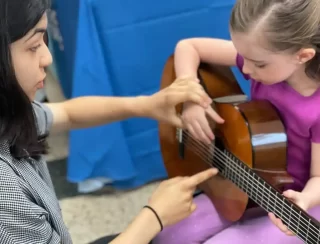Selecting a musical instrument for your child can feel a little like matchmaking — you’re trying to pair them with something that sparks joy, challenges them just enough, and fits into your family’s lifestyle. With so many options out there (and so many opinions!), how do you find the right fit? Here’s a guide to help you and your young musician strike the perfect chord.
1. Consider Your Child’s Interests and Personality
Is your child energetic and outgoing? Is your child more introspective and patient? Watch what music they naturally gravitate toward — kids often show you what they love without even realizing it.
Tip: Take your child to a concert, music store, or let them watch videos of different instruments being played to see what sparks their curiosity.
2. Think About Size and Physical Comfort
Consider your child’s body size, strength, and fine motor skill development when selecting an instrument. Instruments should feel comfortable to hold and easy to reach, or your child may become frustrated and give up.
Tip: Many music stores offer child-sized versions of instruments like violins, guitars, and cellos.
3. Consider the Learning Curve
Some instruments have a steeper learning curve than others. For example, making a clear sound on a violin or French horn can take more practice at the beginning, while the piano or ukulele might offer quicker wins. Early success can boost a young musician’s confidence and motivation to keep going.
Tip: If your child tends to get discouraged easily, starting with a “friendlier” instrument can make the experience more positive.
4. Try Before You Commit
Give your child a chance to test different instruments. Many orchestras and studios offer “instrument petting zoos” where kids can try out a range of options in a relaxed setting. Sometimes the instrument chooses the player! Also, explore musical instrument sampler summer camps where your child can get lots of hands on experience with several types of instruments.
Tip: Private trial lessons can also help — a teacher can assess if an instrument is a good fit based on your child’s physical readiness and interest level.
5. Encourage Exploration and Be Flexible
Kids’ tastes and passions change as they grow. What’s important is that they feel supported to explore music in a way that’s exciting for them. Whether they stick with one instrument for years or hop between a few, they’re building a lifelong love of music. Kids will want to spend more time practicing an instrument that excites them! Their excitement can be channeled into a passion that lasts a lifetime.
Tip: Celebrate effort over perfection, and allow your child to have a say in the instrument selection process. The real win is watching your child find their voic!
